| "Sunlit" Portrait:
(This is my new "Outdoor" Portrait test - read more about it here.)
High resolution and strong detail, with nearly accurate color. Contrast is a little high, with limited detail in the highlights and shadows.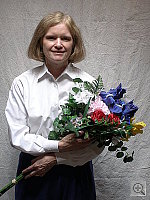
- Exposure compensation: +1.0 EV, about average.
- Contrast/Tone: Contrast is slightly high, but not bad. (Shooting with the low contrast setting helps a great deal here.)
- White Balance: Auto best overall. Daylight and Manual both slightly warm.
- Color accuracy: Very good, though slightly undersaturated, most likely from my use of the low contrast setting. Blues are pretty close to dead-on. Reds and greens about right as well.
- Skin tones: Slightly pale (again, likely due to the low contrast setting), but still nice & natural.
- Resolution/sharpness: Excellent, good definition and detail.
- Shadow detail: Very good, low noise.
To view the entire exposure series from zero to +1.3 EV, see files 7070OUTAP0.HTM through 7070OUTAP4.HTM on the thumbnail index page.
Contrast Series:
A very effective contrast adjustment, covering a wide range in fine steps. Slight interaction with color saturation, but not nearly as much as some.
Saturation Series:
Also a nice control, with a wide range and fine steps.
|
|
Closer Portrait: 
Excellent resolution and detail, but a bit more contrasty.
- Exposure compensation: +0.3 EV, a bit less than average (and 2/3-stop less than the wider shot above).
- Exposure/Tone: Higher contrast in this close-up, resulting in somewhat harsh skin tones.
- Detail: Excellent, lots of very fine detail in the face and hair.
- Distortion: Very little, zoom lens avoids distortion close-in like this.
To view the entire exposure series from zero to +1.3 EV, see files 7070FACAP0.HTM through 7070FACAP4.HTM on the thumbnail index page.
|
|
Indoor Portrait, Flash:
Normal Flash
+1.0 EV
|
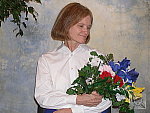 |
Slow-Sync Flash
+1.7 EV
|
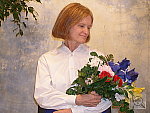 |
Underexposes with the flash at the normal setting, requires an average amount of exposure adjustment to compensate. More even exposure with the Slow-Sync mode, but a stronger warm cast.
- Exposure: Reasonably bright at +1.0 EV in the normal mode, though default exposure is quite dark. Slow-Sync setting produces a much more even exposure at +1.7 EV.
- Flash balance with room lighting?: Excellent in normal flash mode, no sign of bluish highlights from the flash
- Color: Slightly reddish skin tones and dark colors in the bouquet, but still pretty good for this shot. (Better than average.)
To view the entire exposure series from zero to +1.7 EV in the normal flash mode, see files 7070INFP0.HTM through 7070INFP5.HTM on the thumbnail index page.
To view the same exposure series in the Slow-Sync flash mode, see files 7070INFSP0.HTM through 7070INFSP5.HTM on the thumbnail index page.
|
|
Indoor Portrait, No Flash:
|
Auto White Balance
|
 |
|
Incandescent White Balance
|
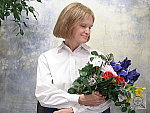 |
|
Manual White Balance
|
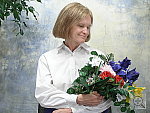 |
Good color with the Incandescent and Manual white balance settings, a little more than average exposure compensation required.
- Exposure: +1.3 EV adjustment needed, a little more than average.
- White Balance: Incandescent very good, just a hint of warmth, mirroring the original lighting. Auto rather reddish. Manual slightly greenish, but some people might prefer it.
- Color: Good skin tones, though blue flowers are purple, remaining color very good though. (A very good performance, given the tough light source.)
To view the entire exposure series from zero to +1.7 EV, see files 7070INMP0.HTM through 7070INMP5.HTM on the thumbnail index page.
ISO Series:
Noise is generally quite unobtrusive with the C-7070. There's some detectable noise in the blue channel even at low ISO settings, but the noise pattern is unusually fine-grained, which makes it much less visible in prints than it would be otherwise. Noise at ISO 400 is on the high side, and some fine detail is traded away to hold it in check, but the noise pattern is fine enough that even prints at 8x10 inches should be acceptable for most uses. At 5x7 inches, noise is a non-issue for all but the most critical applications.
|
|
House Shot:
|
Auto White Balance
|
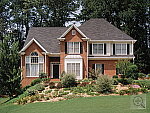 |
|
Daylight White Balance
|
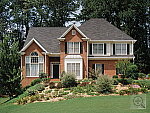 |
|
Manual White Balance
|
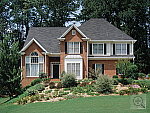 |
Good color with all three white balance settings, with high resolution and strong detail.
- Sharpness/Detail: Excellent, a lot of fine detail.
- Sharpness in Corners: Very slight, much better than average.
- Color: Manual setting best overall, though Auto and Daylight settings also good.
- Detail lost to anti-noise processing?: Minimal.
|
|
Far-Field Test 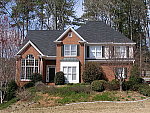
High resolution and strong detail, though a slightly limited dynamic range.
This image is shot at infinity to test far-field lens performance, and to present a near-infinite range of detail to the camera. NOTE that this image cannot be directly compared to the other "house" shot, which is a poster, shot in the studio.
- Sharpness/Detail: Very good, a lot of fine detail and strong definition even in the finer elements. Very slight softness, but no artifacts due to in-camera sharpening. (Low sharpness setting takes unsharp masking in Photoshop(tm) exceptionally well, reveals loads of fine detail.)
- Sharpness in Corners: Very good, much better than average.
- Color: Just about right, very slightly reddish. Accurate hue and saturation.
- Dynamic Range: Pretty good, though some detail loss in the bright highlights.
- Detail lost to anti-noise processing?: Strictly minimal.
Resolution Series:
| Wide Angle |
"Fine"
JPEG |
"Normal"
JPEG |
| 3,072 x 2,304 |
7070FAR3072F
|
7070FAR3072N
|
| 2,592 x 1,944 |
7070FAR2592
|
-
|
| 2,288 x 1,712 |
7070FAR2288
|
-
|
| 2,048 x 1,536 |
7070FAR2048
|
-
|
| 1,600 x 1,200 |
7070FAR1600
|
-
|
| 1,280 x 960 |
7070FAR1280
|
-
|
| 1,024 x 768 |
7070FAR1024
|
-
|
| 640 x 480 |
7070FAR0640
|
-
|
ISO Series:
Color Effects Series:
Sharpness Series:
The C-7070's default sharpening setting produces pretty good results, with very few artifacts from the sharpening process. Still, you can do better in Photoshop, working from images shot with the lowest sharpness setting. (Try unsharp masking of 0.4 pixel radius, 30% on the "-5" image here.)
Contrast Series:
As before, a good contrast adjustment, but with a little impact on color saturation.
Saturation Series:
Looking at these images, I'd say that the best way to handle very high contrast like this might be to set contrast to -5, saturation to +3 or so. - Nice to have such fine-grained and wide-ranging controls for tone and color...
|
|
Lens Zoom Range
A good 4x zoom range.
The C-7070's focal length range of 27-110mm equivalents is a bit broader than that of many digital cameras. Of particular note is how wide it goes at the wide-angle end. (Most digital cameras stop at about 35 mm equivalent, the 27 mm offered by the C-7070 is quite a bit wider.) Overall, the C-7070's zoom range corresponds to a fairly wide angle to a modest telephoto.
|
|
Musicians Poster
|
Auto White Balance
|
 |
|
Daylight White Balance
|
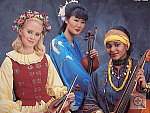 |
|
Manual White Balance
|
 |
Color ranging from warm to cool, but still good results. Very high resolution and strong detail.
- White Balance: Best overall color with the Manual setting (though a hint cool). Auto is warm (likely tricked by the large amount of blue in the composition), and Daylight a bit red.
- Color: Cool skin tones. Blue robe and background slightly purplish, but overall color is pretty good.
- Sharpness/Detail: Excellent. (Probably exceeds the limits of the poster though.)
|
|
Macro Shot
|
Standard Macro Shot
|
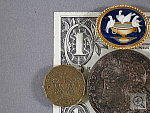 |
|
Macro with Flash
|
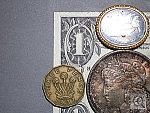 |
|
Super Macro
|
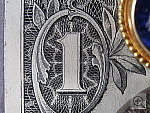 |
Good macro performance in normal mode, exceptional in Super mode. Excellent detail and good color. Flash performs pretty well in normal mode.
- Minimum Macro Area: 2.95 x 2.21 inches (74.9 x 56.2 millimeters) in normal macro mode (good to average), 1.12 x 0.84 inches (28.5 x 21.4 millimeters) in Super Macro. (NOTE that the C-7070 produces the tightest closeups in normal macro mode with the lens set to its telephoto position, not the wide angle position as described in the manual.)
- Softness in corners?: A moderate amount in normal mode, but far less in Super Macro mode. (Most cameras get fairly soft corners in their macro modes.)
- Flash performance in macro mode?: Flash is available in normal Macro mode only, but does quite well there, throttling down well, with only a little falloff in the corners.
|
|
"Davebox" Test Target
|
Auto White Balance
|
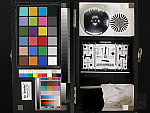 |
|
Daylight White Balance
|
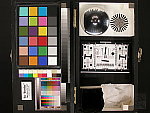 |
|
Manual White Balance
|
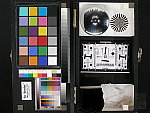 |
Very good color, and a good exposure as well.
- White balance: Auto and Manual settings both produced excellent results, chose Auto for the main shot. Daylight setting a little yellow.
- Color Accuracy: Very good color accuracy, yellows a little dark and strong reds and blues a little hot. Cyan is shifted a little toward pure blues, a common trick to get better-looking sky colors. (Interestingly, the overall color "fingerprint" of the C-7070 is very similar to a lot of Canon cameras currently on the market.) Overall, very good/pleasing color.
- Shadow detail and noise: Good detail in the briquettes, moderately low noise.
Now, for the REAL technoids, Imatest!
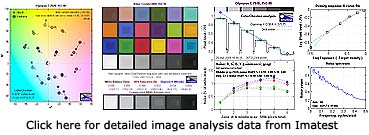
I've recently begun using Norman Koren's excellent "Imatest" analysis program for quantitative, thoroughly objective analysis of digicam test images. For those interested, I've prepared a page summarizing what Imatest showed me about the Olympus C-7070's images.
The images series below duplicate examples of various camera controls we've already covered above. I include them here though, for our more analytically-minded readers, who'd like to see the effect of various camera controls with a well-known target like the MacBeth Color Checker (tm).
ISO Series:
Contrast Series:
Saturation Series:
|
|
Low-Light Tests
Very good low-light performance, with pretty good color and fairly low noise. Focuses to about 0.7 foot-candle without AF illuminator, in total darkness (on nearby objects) with it.
- Exposure limit: 1/16 foot-candle at all ISOs, though the target is slightly dim at this light level in the ISO 80 and 100 shots. (About 1/16 as bright as typical city street lighting at night.)
- Autofocus Limit: About 0.7 foot-candle with the AF illuminator disabled, in total darkness, out to a range of about 8 feet with it turned on.
- White Balance: Slightly pink, but better than average.
- Noise Levels: Fairly low in most shots, though a bit higher at ISO 400. Noise Reduction mode doesn't seem to make a lot of difference here, because there aren't a lot of "hot pixels" anyway.
- Detail loss to anti-noise processing?: Minimal at one foot-candle, noticeable at 1/16 foot-candle.
- General Notes: The C-7070 is a very capable low-light shooter, but I wouldn't mind seeing it have better low light focusing ability when its AF illuminator is turned off. Still though, this is a camera that should bring back good-looking pictures from conditions about as dim as you'd probably want to walk around in.
(Note: If you'd like to use a light meter to check light levels for subjects you might be interested in shooting, a light level of one foot-candle corresponds to a normal exposure of two seconds at f/2.8 and ISO 100.)
| |
1 fc
11 lux |
1/2 fc
5.5 lux |
1/4 fc
2.7 lux |
1/8 fc
1.3 lux |
1/16 fc
0.67 lux |
1/16fc
No NR |
ISO
80 |

1.6 sec
f2.8 |

4 sec
f2.8 |

8 sec
f2.8 |

15 sec
f2.8 |

15 sec
f2.8 |

15 sec
f2.8 |
ISO
100 |

1.3 sec
f2.8 |

3.2 sec
f2.8 |

6 sec
f2.8 |

15 sec
f2.8 |

15 sec
f2.8 |

15 sec
f2.8 |
ISO
200 |

1/1 sec
f2.8 |

1.6 sec
f2.8 |

4 sec
f2.8 |

8 sec
f2.8 |

15 sec
f2.8 |

15 sec
f2.8 |
ISO
400 |

1/2 sec
f2.8 |

1/1 sec
f2.8 |

2 sec
f2.8 |

4 sec
f2.8 |

8 sec
f2.8 |

8 sec
f2.8 |
|
|
Flash Range Test
Slightly underexposed at eight feet, but about the same brightness level to 10 feet. Intensity decreases slightly from that point on.
- Flash range at telephoto lens setting: 10 feet, falloff from there.
| 8 ft |
9 ft |
10 ft |
11 ft |
12 ft |
13 ft |
14 ft |

1/100 sec
f5.6
ISO 80 |

1/100 sec
f5.6
ISO 80 |

1/100 sec
f5.6
ISO 80 |

1/100 sec
f5.6
ISO 80 |

1/100 sec
f5.6
ISO 80 |

1/100 sec
f5.6
ISO 80 |

1/100 sec
f5.6
ISO 80 |
|
|
ISO-12233 (WG-18) Resolution Test 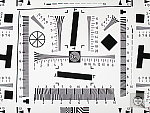
Good resolution, 1,550 lines of "strong detail." Higher than average barrel distortion at wide angle, but almost no distortion at telephoto. Moderate chromatic aberration at wide angle, almost none at telephoto. Good sharpness in corners, best at wide angle.
- Resolution: 1,550 lines both vertically and horizontally.
- Artifacts begin at: ~1,200 lines.
- Extinction point: ~1,850 lines.
- Barrel/Pincushion distortion: 1.1 percent barrel at wide angle, 0.03 percent at telephoto (one pixel).
- Chromatic Aberration: Moderate at wide angle, very low at telephoto.
- Corner Sharpness: Slightly soft at wide angle, and less at telephoto.
Resolution Series:
| Wide Angle |
Uncompressed
TIFF |
"Fine"
JPEG |
"Normal"
JPEG |
| 3,072 x 2,304 |
7070RES.TIF
|
7070RES3072F
|
7070RES3072N
|
| 2,592 x 1,944 |
-
|
7070RES2592
|
-
|
| 2,288 x 1,712 |
-
|
7070RES2288
|
-
|
| 2,048 x 1,536 |
-
|
7070RES2048
|
-
|
| 1,600 x 1,200 |
-
|
7070RES1600
|
-
|
| 1,280 x 960 |
-
|
7070RES1280
|
-
|
| 1,024 x 768 |
-
|
7070RES1024
|
-
|
| 640 x 480 |
-
|
7070RES0640
|
-
|
Resolution Test, Zoom Series
3,072 x 2,304
(Fine,
Wide Angle) |
7070RESW
|
3,072 x 2,304
(Fine,
Telephoto) |
7070REST
|
|
Viewfinder Accuracy/Flash Uniformity
An accurate LCD monitor, but tight optical viewfinder. Slight flash falloff at wide angle, and a lesser amount at telephoto.
- Optical Viewfinder Accuracy: 84 percent at wide angle, 83 percent at telephoto.
- LCD Viewfinder Accuracy: Very good, 99 percent at wide angle, just slightly loose at telephoto (the measurement lines didn't make it into the shot).
- Flash Uniformity: Slight falloff at wide angle (better than average though), and a smaller amount at telephoto.
|

Follow Imaging Resource: